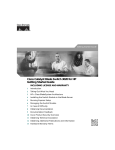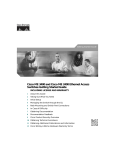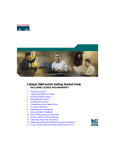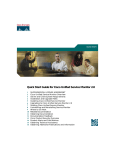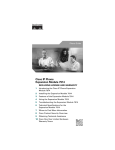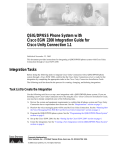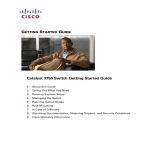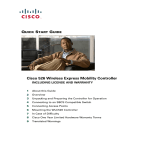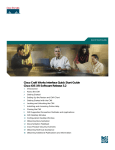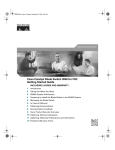Download Cisco 3750G - Catalyst Integrated Wireless LAN Controller Specifications
Transcript
Getting Started
Guide
Catalyst 3750G Integrated Wireless LAN Controller Switch
Getting Started Guide
INCLUDING LICENSE AND WARRANTY
1
About this Guide
2
Taking Out What You Need
3
Running Express Setup
4
Managing the Switch
5
Preparing the Wireless LAN Controller for Operation
6
Planning Switch Stacks
7
Rack-Mounting
8
In Case of Difficulty
9
Obtaining Documentation
10 Documentation Feedback
11 Cisco Product Security Overview
12 Obtaining Technical Assistance
13 Obtaining Additional Publications and Information
14 Cisco Limited Lifetime Hardware Warranty Terms
1 About this Guide
This guide provides instructions on how to use Express Setup to initially configure your
Catalyst 3750G Integrated Wireless LAN Controller switch. It also covers switch management
options, the configuration procedures for the controller, basic rack-mounting procedures, stacking,
port and module connections, power connection procedures, and any troubleshooting help.
The Catalyst 3750G Integrated Wireless LAN Controller switch has an integrated Cisco wireless LAN
controller that can support Cisco Lightweight Access Points. The switch also has two internal Gigabit
Ethernet ports (ports 27 and 28) that connect the switch and the controller. The integrated wireless
LAN controller centralizes and simplifies network management of a wireless LAN. It collapses large
numbers of managed lightweight access points and client devices into a single unified system.
For additional installation and configuration information for wireless LAN controller switches, see the
Catalyst 3750 documentation on Cisco.com. For more information on the controller, see the Cisco
Wireless LAN Controller Configuration Guide, Release 4.0 or later on Cisco.com. For system
requirements, important notes, limitations, open and resolved caveats, and last-minute documentation
updates, see the release notes, also on Cisco.com.
When using the online publications, refer to the documents that match the Cisco IOS software version
running on the switch. The software version is on the Cisco IOS label on the switch rear panel.
For translations of the warnings that appear in this publication, see the Regulatory Compliance and
Safety Information for the Catalyst 3750 Switch that accompanies this guide.
2 Taking Out What You Need
Follow these steps:
1. Unpack and remove the switch and the accessory kit from the shipping box.
2. Return the packing material to the shipping container, and save it for future use.
3. Verify that you have received the items shown on page 3. If any item is missing or damaged,
contact your Cisco representative or reseller for instructions.
Note
2
If you do not specify the length of the StackWise cable, the 0.5-meter cable is supplied.
Shipping Box Contents
SYST
RPS
MASTR
STAT
DUPLX
SPEED
STACK
PoE
1
2
1X
3
Catalyst
3750G
Wireless SERIES PoE-2
LAN Contro 4
ller
4
5
6
7
8
9
10
11
12
11X
13
13X
Catalyst 3750G
Integrated Wireless LAN
Controller switch
2X
14
15
16
17
18
19
20
21
22
23
24
23X
12X
14X
24X
25
26
Two 19-inch
mounting brackets
Four number-12 Phillips machine screws
0.5-meter, 1-meter or 3-meter
StackWise cable
Four number-8 Phillips truss-head screws
Six number-8 Phillips flat-head screws
Connector cover for redundant
power system (RPS)
Console cable
Two number-4 pan-head screws
AC power cord
ct
O
nc
ne
w
tio
ip
h
rs
ard
Documentation
e
nc
ia on
pl ati
om rm
h
C o
itc
y Inf
w
or y e S
at et th 0
ul af for 75
eg S
t3
R d
ys
al
at
o
u
tra
One black Phillips machine screw
C
sc
d
ro
Ci
gis
an
0G ss h
75 ele itc
t 3 ir w de
ys W S ui
al d er G
at te ll d
C gra tro rte
n
te o ta
In C S
N ng
i
LA ett
G
P
Re
Cable guide
Four rubber mounting feet
3
Equipment that You Supply to Run Express Setup
You need to supply this equipment to run Express Setup:
• PC
• Ethernet (Category 5) straight-through cable (as shown)
3 Running Express Setup
When you first set up the switch, you should use Express Setup to enter the initial IP information.
Doing this enables the switch to connect to local routers and the Internet. You can then access the
switch through the IP address for further configuration.
To run Express Setup:
Step 1
Verify that no devices are connected to the switch. During Express Setup, the switch acts
as a DHCP server. If your PC has a static IP address, before you begin, change your PC
settings to temporarily use DHCP.
Step 2
Connect the AC power cord to the switch and to a grounded AC outlet. The power-on
self-test (POST) begins. During POST, the LEDs blink while a series of tests verify that the
switch functions properly.
Step 3
Wait for the switch to complete POST. It might take several minutes for the switch to
complete POST.
Step 4
Verify that POST has completed by confirming that the SYST LED remains green. If the
switch fails POST, the SYST LED turns amber.
POST errors are usually fatal. Call Cisco Systems immediately if your switch fails POST.
4
Step 5
Press and hold the Mode button for
3 seconds. When all of the LEDs
above the Mode button turn green,
release the Mode button.
If the LEDs above the Mode button
begin to blink after you press the
button, release it. Blinking LEDs
mean that the switch has already
been configured and cannot go into
Express Setup mode. For more
information, see the “Resetting the
Switch” section on page 35.
SYST
RPS
MASTR
STAT
DUPLX
SPEED
STACK
PoE
Mode button
Step 6
Verify that the switch is in Express Setup mode by confirming that all LEDs above the
Mode button are green. (On some switch models, the RPS LED remains off.)
Step 7
Connect a straight-through
Category 5 Ethernet cable (not
provided) to any 10/100/1000
Ethernet port on the switch front
panel and to the Ethernet port on the
PC.
SYST
RPS
MASTR
STAT
DUPLX
SPEED
STACK
PoE
1
1X
2
3
Catalyst
3750G
Wireless SERIES PoE-24
LAN Controlle
r
4
5
6
7
8
9
10
11
12
11X
13
13X
2X
14
15
16
17
18
19
20
21
22
23
24
23X
12X
14X
24X
25
26
DHCP-enabled PC
Step 8
Verify that the LEDs on both Ethernet ports are green.
Step 9
Wait 30 seconds.
Step 10
Launch a web browser on your PC.
Enter the IP address 10.0.0.1 in the
web browser, and press Enter.
5
Step 11
The Express Setup page appears. If it does not appear, see the “In Case of Difficulty”
section on page 34 for help.
Step 12
Enter this information in the Network Settings fields:
• In the Management Interface (VLAN ID) field, the default is 1. Enter a new VLAN ID
only if you want to change the management interface through which you manage the
switch and to which you assign IP information. The VLAN ID range is 1 to 1001.
• In the IP Address field, enter the IP address of the switch. In the IP Subnet Mask field,
click the drop-down arrow, and select an IP Subnet Mask.
• In the Default Gateway field, enter the IP address for the default gateway (router).
• Enter your password in the Switch Password field. The password can be from 1 to 25
alphanumeric characters, can start with a number, is case sensitive, allows embedded
spaces, but does not allow spaces at the beginning or end. In the Confirm Switch
Password field, enter your password again.
6
Step 13
In the Wireless Controller Settings area (see the Figure in Step 11), the stack number
displays the stack-member number of the switch.
Enter this information:
• In the Management Interface (VLAN ID) field, the default is 0. Enter a new VLAN ID
only if you want to change the management interface through which you manage the
controller and to which you assign IP information. If you entered a VLAN ID other
than 1 in Step 12, then enter the same VLAN ID for the controller. The VLAN ID
range is 0 to 1001.
• In the IP Address field, enter the IP address of the controller.
• In the IP Subnet Mask field, click the drop-down arrow, and select an IP Subnet Mask.
• In the Default Gateway field, enter the IP address for the default gateway (router).
Note
If you are connecting more than one wireless controller switch, multiple rows
appear in the wireless controller settings area.
7
Step 14
(Optional) You can enter the Optional Settings information now or enter it later by using
the device manager interface:
• In the Host Name field, enter a name for the switch. The host name is limited to
31 characters; embedded spaces are not allowed.
• In the Telnet Access field, click Enable if you are going to use Telnet to manage the
switch by using the command-line interface (CLI). If you enable Telnet access, you
must enter a Telnet password.
• In the Telnet Password field, enter a password. The Telnet password can be from
1 to 25 alphanumeric characters, is case sensitive, allows embedded spaces, but does
not allow spaces at the beginning or end. In the Confirm Telnet Password field,
re-enter the Telnet password.
• In the SNMP field, click Enable to enable Simple Network Management Protocol
(SNMP). Enable SNMP only if you plan to manage switches by using
CiscoWorks 2000 or another SNMP-based network-management system.
If you enable SNMP, you must enter a community string in the SNMP Read
Community field, the SNMP Write Community field, or both. SNMP community
strings authenticate access to MIB objects. Embedded spaces are not allowed in
SNMP community strings. When you set the SNMP read community, you can access
SNMP information, but you cannot modify it. When you set the SNMP write
community, you can both access and modify SNMP information.
• In the System Contact field, enter the name of the person who is responsible for the
switch. In the System Location field, enter the wiring closet, floor, or building where
the switch is located.
Step 15
Click Submit to save your settings, or click Cancel to clear your settings.
When you click Submit, the switch is configured and exits Express Setup mode. The PC
displays a warning message and then tries to connect with the new switch IP address. If
you configured the switch with an IP address that is in a different subnet from the PC,
connectivity between the PC and the switch is lost.
Step 16
Disconnect the switch from the PC, and install the switch in your network. See the
“Managing the Switch” section on page 9 for information about configuring and
managing the switch.
If you need to rerun Express Setup, see the “Resetting the Switch” section on page 35.
8
Refreshing the PC IP Address
After you complete Express Setup, you should refresh the PC IP address:
• For a dynamically assigned IP address, disconnect the PC from the switch, and reconnect it to the
network. The network DHCP server assigns a new IP address to the PC.
• For a statically assigned IP address, change it to the previously configured IP address.
4 Managing the Switch
After you complete Express Setup and install the switch in your network, use the device manager or
other management options described in this section for further configuration.
Using the Device Manager
The simplest way to manage the switch is by using the device manager that is in the switch memory.
This is an easy-to-use web interface that offers quick configuration and monitoring. You can access
the device manager from anywhere in your network through a web browser.
Follow these steps:
1. Launch a web browser on your PC or workstation.
2. Enter the switch IP address in the web browser, and press Enter. The device manager page appears.
3. Use the device manager to perform basic switch configuration and monitoring. Refer to the device
manager online help for more information.
4. For more advanced configuration, download and run the Cisco Network Assistant, which is
described in the next section.
Downloading Cisco Network Assistant
Cisco Network Assistant is a software program that you download from Cisco.com and run on
your PC. It offers advanced options for configuring and monitoring multiple devices, including
switches, switch clusters, switch stacks, routers, and access points. Network Assistant is free—there is
no charge to download, install, or use it.
Follow these steps:
1. Go to this Web address: http://www.cisco.com/go/NetworkAssistant.
You must be a registered Cisco.com user, but you need no other access privileges.
2. Find the Network Assistant installer.
9
3. Download the Network Assistant installer, and run it. (You can run it directly from the Web if
your browser offers this choice.)
4. When you run the installer, follow the displayed instructions. In the final panel, click Finish to
complete the Network Assistant installation.
Refer to the Network Assistant online help and the getting started guide for more information.
Command-Line Interface
You can enter Cisco IOS commands and parameters through the CLI. Access the CLI either by
connecting your PC directly to the switch console port or through a Telnet session from a remote PC
or workstation.
Follow these steps:
1. Connect the supplied RJ-45-to DB-9 adapter cable to the standard 9-pin serial port on the PC.
Connect the other end of the cable to the switch console port.
2. Start a terminal-emulation program on the PC.
3. Configure the PC terminal emulation software for:
– 9600 baud
– 8 data bits
– No parity
– 1 stop bit
– No flow control
4. Use the CLI to enter commands to configure the switch. See the software configuration guide and
the command reference for more information.
Other Management Options
You can use SNMP management applications such as CiscoWorks Small Network Management
Solution (SNMS) and HP OpenView to configure and manage the switch. You also can manage it
from an SNMP-compatible workstation that is running platforms such as HP OpenView or
SunNet Manager.
The Cisco IE2100 Series Configuration Registrar is a network management device that works with
embedded Cisco Networking Services (CNS) agents in the switch software. You can use IE2100 to
automate initial configurations and configuration updates on the switch.
See the “Accessing Help Online” section on page 36 for a list of supporting documentation.
10
5 Preparing the Wireless LAN Controller for Operation
Follow these major steps to prepare the integrated wireless LAN controller for operation.
• Using the Configuration Wizard to Configure the Controller
• Logging into the Controller
• Verifying Interface Settings and Port Operation
• Connecting Access Points
Using the Configuration Wizard to Configure the Controller
Follow these steps to use the Configuration Wizard to configure the controller for basic operation:
Step 1
Get the initial configuration parameter settings for the controller from your wireless LAN
planner.
Step 2
Launch a web browser on your PC.
Step 3
If you have not already done so, assign a static IP address to your PC from the same subnet
as the switch; otherwise, the web browser cannot establish a connection with the switch.
11
Step 4
Enter the management IP address of the switch (which you set in Step 12 of the Express
Setup) in the web browser, and press Enter. The Catalyst 3750 Device Manager page
appears.
Step 5
Under Contents, click Controller Device Manager.
Step 6
When prompted for a username and password, enter admin in each field. The first page
of the Configuration Wizard appears.
12
Step 7
In the System Name field, enter the system name, which is the name that you want to
assign to the controller. You can enter up to 32 ASCII characters.
Step 8
In the User Name and Password fields, enter the administrative username and password
for this controller. You can enter up to 24 ASCII characters for each. The default
administrative username and password are both admin.
Step 9
Click Next. The Service Interface Configuration page appears.
Step 10
If you want the controller service-port interface to get an IP address from a DHCP server,
check the DHCP Protocol Enabled check box. If you do not want to use the service port
or if you want to assign a static IP address to the service-port interface, leave the check
box unchecked.
The service-port interface controls communications through the service port, which is
reserved for out-of-band management of the controller and for system recovery and
maintenance in the event of a network failure. Its IP address must be on a different subnet
from the management and AP-manager interfaces. You can use this configuration to
manage the controller directly or through a dedicated management network to ensure
service access during network downtime.
Step 11
If you did not check the DHCP Protocol Enabled check box in Step 10, leave the IP
address and the netmask for the service-port interface as they are, or change them as
necessary. If you do not want to use the service port, enter 0.0.0.0 for both the IP address
and the netmask.
13
Step 12
Click Next. The Management Interface Configuration page appears.
Step 13
Enter the VLAN identifier zero (0) if the VLAN ID set on the switch management interface
is 1. If you entered a VLAN ID other than 1 on the switch management interface (see Step
12 of the Running Express Setup section), enter the same VLAN ID for the controller.
Enter the IP address, the netmask, and the gateway for the management interface.
The management interface is the default interface for in-band management of the
controller and for connectivity to enterprise services such as authentication, authorization,
and accounting (AAA) servers.
Step 14
14
Enter the IP addresses of the primary and the optional secondary DHCP servers that
supply IP addresses to clients, the controller management interface, and, optionally, the
service-port interface.
Step 15
Click Next. The Miscellaneous Configuration page appears.
15
Step 16
From the LWAPP Transport Mode drop-down box, choose Layer 3. The controller
operates only in Layer 3 mode.
Step 17
(Optional) In the RF Mobility Domain Name field, enter the name of the mobility group/
RF group to which you want the controller to belong.
Although the name that you enter here is assigned to both the mobility group and the RF
group, these groups are not identical. Both groups define clusters of controllers, but they
have different purposes. All of the controllers in an RF group are usually also in the same
mobility group and the reverse. However, a mobility group facilitates scalable,
system-wide mobility and controller redundancy, while an RF group facilitates scalable,
system-wide dynamic RF management.
Step 18
In the Country Code field, enter the code for the country in which the controller will be
used. See the table below the Country Code field for the list of available country codes.
Step 19
Click Next. The AP Manager Interface Configuration page appears.
Step 20
Enter the VLAN identifier, the IP address, the netmask, and the gateway for the controller
AP-manager interface.
The AP-manager interface is used for Layer 3 communications between the controller and
lightweight access points and must have a unique IP address. It is usually configured on
the same VLAN or IP subnet as the management interface, but this is not a requirement.
16
Step 21
Enter the IP addresses of the primary and the optional secondary DHCP servers that
supply IP addresses to the controller AP-manager interface. If the AP-manager interface is
on the same subnet as the management interface, the AP-manager interface uses the same
DHCP server IP address as the management interface.
Step 22
Click Next. The Virtual Interface Configuration page appears.
Step 23
In the IP Address field, enter the IP address of the controller virtual interface to be used
by all controller Layer 3 security and mobility managers. You should enter a fictitious,
unassigned IP address, such as 1.1.1.1.
The virtual interface is used to support mobility management, DHCP relay, and embedded
Layer 3 security such as guest web authentication and VPN termination. All controllers
within a mobility group must be configured with the same virtual interface IP address.
Step 24
In the DNS Host Name field, enter the DNS host name if your controller uses an externally
generated web authentication ID certificate that includes a DNS hostname.
17
Step 25
Click Next. The WLAN Policy Configuration page appears.
Step 26
In the WLAN SSID field, enter the network name or service set identifier (SSID). This is
the default SSID that the access points use when they join a controller.
Step 27
Under General Policies, check the DHCP Address Assignment Required check box to
make clients request an IP address from a DHCP server, or uncheck this check box to allow
clients to assign their own IP addresses.
Step 28
Leave the rest of the parameters on this page at their default values, or change them to
meet your deployment needs. Refer to the online help for additional information on
specific parameters.
18
Step 29
Click Next. The RADIUS Server Configuration page appears.
Step 30
To configure a RADIUS server now, enter the IP address, the shared secret, and the
communication port of the RADIUS server, and click Apply. Otherwise, click Skip. The
IEEE 802.11 Configuration page appears.
Step 31
Check or uncheck the 802.11a, 802.11b, and 802.11g Network Status check boxes to
enable or disable each of the IEEE 802.11a, IEEE 802.11b, and IEEE 802.11g lightweight
access point networks.
19
Step 32
Check or uncheck the Auto RF check box to enable or disable the controller radio resource
management (RRM) auto-RF feature.
The auto-RF feature enables the controller to automatically form an RF group with other
controllers. The group dynamically elects a leader to optimize RRM parameter settings,
such as channel and send power assignments, for the group.
Step 33
Click Next. The Configuration Wizard Completed page appears.
Step 34
Click Save and Reboot.
Step 35
When prompted, click OK to confirm the reboot. The controller saves your configuration
and reboots. The reboot process can take several minutes, so you might need to wait
before accessing your web browser again.
Logging into the Controller
Follow these steps to log into the controller from the switch.
Step 1
Telnet to the switch by using the switch IP address.
Step 2
At the switch system prompt, enter session 1 processor 1, and press Enter. The session
number is linked to the controller. If there are two switches and you want to access
controller number 2, you would enter session 2 processor 1.
Step 3
When prompted, enter a valid username and password to log into the controller, and press
Enter. The administrative username and password were assigned in the Configuration
Wizard and are case sensitive.
20
Verifying Interface Settings and Port Operation
Follow these steps to verify that your interface configurations have been set properly and that the
controller ports are operational.
Step 1
Enter show interface summary, and press Enter. This display shows the controller interface
configurations:
Interface Name
Port Vlan Id
------------------------------ ---- -------ap-manager
LAG
10
management
LAG
10
service-port
N/A
N/A
virtual
N/A
N/A
IP Address
Type
Ap Mgr
-------------- ------- ----10.91.104.99
Static
Yes
10.91.104.93
Static
No
10.10.0.9
Static
No
1.1.1.1
Static
No
Link aggregation (LAG) is always enabled for the integrated wireless LAN controller and
cannot be disabled. LAG bundles all of the controller distribution system ports into a
single IEEE 802.3ad port channel. See the Cisco Wireless LAN Controller Configuration
Guide 4.0 or later for more information.
Step 2
Enter show port summary, and press Enter. This display shows the status of the controller
distribution system ports, which serve as the data path between the controller and the
Cisco lightweight access points and to which the controller management and AP-manager
interfaces are mapped.
STP
Admin
Physical
Physical
Pr Type
Stat
Mode
Mode
Status
-- ------- ---- ------- ---------- ---------1 Normal Forw Enable Auto
1000 Full
2 Normal Forw Enable Auto
1000 Full
Link
Link
Mcast
Status Trap
Appliance
POE
------ ------- --------- ------Up
Enable Enable
N/A
Up
Enable Enable
N/A
A link status of Up means that the controller ports are fully operational.
21
Connecting Access Points
After you have configured the controller, use Category-5, -5e, -6, or -7 Ethernet cables to connect
Cisco lightweight access points to the network.
As soon as the controller is operational, it starts to scan for access points. When it detects one, it
records the its MAC address in its database. The controller RRM feature then automatically configures
the access point to start sending and allowing clients to associate.
SYST
RPS
MASTR
STAT
DUPLX
SPEED
STACK
PoE
1
1X
2
3
Catalyst
3750G SERIES
Wireles
PoE-24
s LAN Control
ler
4
5
6
7
8
9
10
11
12
11X
13
13X
2X
14
15
16
17
18
19
20
21
22
23
24
23X
12X
14X
24X
25
Network
155041
Cisco
Access Points
For the integrated wireless LAN controller, access points can operate only in Layer 3 Lightweight
Access Point Protocol (LWAPP) mode.
You have prepared the controller for basic operation. See the Cisco Wireless LAN Controller
Configuration Guide, Release 4.0 or later, for information on configuring the controller to meet the
specific needs of your wireless network.
22
6 Planning Switch Stacks
Before connecting the Catalyst 3750 switches in a stack, keep in mind these planning considerations:
• The size of the switch—See the“Technical Specifications” appendix of the Catalyst 3750 Switch
Hardware Installation Guide for the switch dimensions. Stacking together switches of the same
size makes it easier to cable the switches.
• Length of cable—Depending on the configuration of your switch stack, you might need
different-sized cables. If you do not specify the length of the StackWise cable, the 0.5-meter cable
is supplied. If you require the 1-meter cable or 3-meter cable, you can order it from your Cisco
supplier. For cable numbers, see the Catalyst 3750 Switch Hardware Installation Guide.
Note
For concepts and procedures for managing switch stacks, refer to the switch software
configuration guide.
Powering Considerations
Consider these guidelines before you power the switches in a stack:
• The sequence in which the switches are
initially powered on might affect the switch
that becomes the stack master.
• If you want a particular switch to become the
stack master, power on that switch first. This
switch becomes the stack master and remains
the stack master until a master re-election is
required. After 20 seconds, power on the
remaining switches in the stack.
Note
• If you have no preference for which switch
becomes the stack master, power on all the
switches in the stack within a 20-second
timeframe. These switches participate in the
stack master election. Switches powered on
after the 20-second timeframe do not
participate in the election.
• Power off a switch before you add it to or
remove it from an existing switch stack.
Stack master elections occur over a 10-second timeframe on switches running releases earlier
than Cisco IOS Release 12.2(20)SE3.
For more information on stack master elections, see the “Managing Switch Stacks” chapter
in the switch software configuration guide.
23
Cabling Considerations
These illustrations show the recommended Catalyst 3750 switch stack configurations with redundant
StackWise cabling connections for optimized stack bandwidth. For more configuration examples, see
the Catalyst 3750 Switch Hardware Installation Guide on Cisco.com.
Vertical Stacking
86586
In this example, the stack uses the 0.5-meter StackWise cable to make redundant connections.
86585
In this example, the stacks use both 0.5- and 3-meter StackWise cables to make redundant connections.
24
Side-By-Side Stacking
86825
In this example, eight switches are stacked side-by-side with redundant connections by using 0.5- and
3-meter StackWise cables.
90532
In this example, nine switches are stacked side-by-side with redundant connections by using 0.5- and
3-meter StackWise cables.
7 Rack-Mounting
This section covers basic 19-inch rack-mounting and switch port connections. For additional cabling
information, see the Catalyst 3750 Switch Hardware Installation Guide on Cisco.com.
Equipment That You Supply
You need to supply a number-2 Phillips screwdriver to rack-mount the switch.
25
Before You Begin
When determining where to install the switch, verify that these guidelines are met:
• Airflow around the switch and through the
vents is unrestricted.
• Temperature around the switch does not
exceed 113°F (45°C).
• Humidity around the switch does not exceed
85 percent.
• Altitude at the installation site is not greater
than 10,000 feet.
• Clearance to the switch front and rear panels
meets these conditions:
– Front-panel LEDs can be easily read.
– Access to ports is sufficient for
unrestricted cabling.
– AC power cord can reach from the
AC power outlet to the connector on the
switch rear panel.
– Access to the rear of the rack is sufficient
for connecting StackWise cables to
stacked switches.
26
• Cabling is away from sources of electrical
noise, such as radios, power lines, and
fluorescent lighting fixtures.
• For 10/100/1000 ports, the cable length from
a switch to an attached device cannot exceed
328 feet (100 meters).
• For cable lengths for small form-factor
pluggable (SFP) modules, see the
documentation that shipped with the module.
Installation Warning Statements
This section includes the basic installation warning statements. Translations of these warning
statements appear in the Regulatory Compliance and Safety Information for the Catalyst 3750 Switch
document that shipped with the switch and is also available on Cisco.com.
Warning
Only trained and qualified personnel should be allowed to install, replace, or service this
equipment. Statement 148
Warning
Installation of the equipment must comply with local and national electrical codes.
Statement 1074
Warning
To prevent the switch from overheating, do not operate it in an area that exceeds the
maximum recommended ambient temperature of 113°F (45°C). To prevent airflow
restriction, allow at least 3 inches (7.6 cm) of clearance around the ventilation openings.
Statement 17B
Warning
To prevent bodily injury when mounting or servicing this unit in a rack, you must take
special precautions to ensure that the system remains stable. The following guidelines
are provided to ensure your safety:
• This unit should be mounted at the bottom of the rack if it is the only unit in the rack.
• When mounting this unit in a partially filled rack, load the rack from the bottom to the top with
the heaviest component at the bottom of the rack.
• If the rack is provided with stabilizing devices, install the stabilizers before mounting or
servicing the unit in the rack. Statement 1006
27
Warning
This equipment must be grounded. Never defeat the ground conductor or operate the
equipment in the absence of a suitably installed ground conductor. Contact the
appropriate electrical inspection authority or an electrician if you are uncertain that
suitable grounding is available. Statement 1024
Warning
If a redundant power system (RPS) is not connected to the switch, install an RPS
connector cover on the back of the switch. Statement 265
Warning
Class 1 laser product. Statement 1008
Warning
For connections outside the building where the equipment is installed, the following
ports must be connected through an approved network termination unit with integral
circuit protection: 10/100/1000 Ethernet. Statement 1044
Warning
Voltages that present a shock hazard may exist on Power over Ethernet (PoE) circuits if
interconnections are made using uninsulated exposed metal contacts, conductors, or
terminals. Avoid using such interconnection methods, unless the exposed metal parts
are located within a restricted access location and users and service people who are
authorized within the restricted access location are made aware of the hazard. A
restricted access area can be accessed only through the use of a special tool, lock and
key or other means of security. Statement 1072
28
Attaching the Brackets
Use four Phillips flat-head screws to attach the long side of the brackets to wireless controller LAN
switches in one of three mounting positions.
SYST
RPS
MASTR
STAT
DUPLX
SPEED
STACK
PoE
1
2
3
1X
Catalyst
3750G
Wireless SERIES PoE-2
LAN Contr 4
oller
4
5
6
7
8
9
10
11
12
11X
13
14
13X
15
16
17
18
2X
19
20
21
22
23
24
23X
12X
14X
25
24X
26
Front-mounting position
Number-8 Phillips
flat-head screws
SYST
RPS
MASTR
STAT
DUPLX
SPEED
STACK
PoE
1
1X
2
3
Catalyst
3750G
Wireless SERIES PoE-2
LAN Contr 4
oller
4
5
6
7
8
9
10
11
12
11X
13
13X
2X
14
15
16
17
18
19
20
21
22
23
24
23X
12X
14X
24X
25
26
Mid-rack-mounting position
(telco rack)
CONTROLL
ER
CONSOLE
STACK
A
STACK
B
SWITCH
CONSOLE
SERVICE
DC INPUT
S
POWERFOR REMOTE
SUPPLY
SPECIFIED
IN MANU
AL
Rear-mounting position
29
Rack-Mount the Switch
Use the black Phillips machine screw to attach the cable guide to the left or right bracket. Use the four
number-12 Phillips machine screws to attach the brackets to the rack.
Cable
guide
SYST
RPS
MASTR
STAT
DUPLX
SPEED
STACK
PoE
1
2
3
1X
Catalyst
3750G
Wireless SERIES PoE-2
LAN Contr 4
oller
4
5
6
7
8
9
10
11
12
11X
13
14
13X
15
16
17
18
2X
Black Phillips
machine screw
19
20
21
22
23
24
23X
12X
14X
24X
25
26
Number-12 Phillips
machine screws
Front-mounting position
SYST
RPS
MASTR
STAT
DUPLX
SPEED
STACK
PoE
1
1X
2
3
Catalyst
3750G
Wireless SERIES PoE-2
LAN Contr 4
oller
4
5
6
7
8
9
10
11
12
11X
13
13X
2X
14
15
16
17
18
19
20
21
22
23
24
23X
12X
14X
24X
25
26
Mid-rack-mounting position
(telco rack)
CONTROLL
ER
CONSOLE
STACK
A
STACK
B
SWITCH
CONSOLE
SERVICE
DC INPUT
S
POWERFOR REMOTE
SUPPLY
SPECIFIED
IN MANU
AL
Rear-mounting position
30
Connect the StackWise Cables
Follow these steps to connect the StackWise cable to the StackWise ports:
Step 1
Remove the dust covers from the StackWise cables and StackWise ports, and store
them for future use.
Step 2
Insert one end of the
StackWise cable into the
StackWise port on the back
of the switch.
STACK
1
STACK
2
CONSOL
E
Step 3
Use the window in the StackWise cable to align the connector correctly. Secure the
screws tightly.
Step 4
Insert the other end of the cable into the connector of the other switch, and secure
the screws tightly.
Caution
Note
Removing and inserting the StackWise cable can shorten its useful life. Do not remove and
insert the cable more often than is absolutely necessary.
Always use a Cisco-approved StackWise cable to connect the switches.
31
Connect to the Switch Ports
This section describes how to connect to the fixed switch ports and the SFP module ports.
Connect to 10/100/1000 Ports
Follow these steps:
Step 1
When you connect to servers,
workstations, IP phones, wireless
access points, and routers, insert a
straight-through, twisted four-pair,
Category 5 cable in a switch
10/100/1000 port.
Catalyst
3750
Wireless G SERIES PoE-2
4
LAN Co
ntroller
13
13X
14
15
16
17
18
19
20
21
22
23
24
23X
Use a crossover, twisted four-pair,
Category 5 cable when you connect to
other switches, hubs, or repeaters.
14X
24X
25
26
10/100/1000 ports
Step 2
Insert the other cable end into an RJ-45 connector on the other device.
The fixed ports on the Catalyst 3750 Power over Ethernet (PoE) switches provide PoE support for
IEEE 802.3af-compliant devices. They also provide Cisco pre-standard PoE support for Cisco
IP Phones and Cisco Aironet Access Points.
Each of the 24 10/100/1000 switch ports can deliver up to 15.4 W of PoE. Any combination of the
ports can deliver an average of 7.7 W of PoE at the same time, up to a maximum switch power output
of 370 W.
By default, a Catalyst 3750 switch PoE port automatically provides power when a valid powered
device is connected to it. For information about configuring and monitoring PoE ports, see the switch
software configuration guide. For information about troubleshooting PoE problems, see the
Catalyst 3750 Switch Hardware Installation Guide on Cisco.com.
Note
32
The automatic medium-dependent interface crossover (auto-MDIX) feature is enabled by
default on switches running Cisco IOS Release 12.2(18)SE or later. When the auto-MDIX
feature is enabled, the switch detects the required cable type for copper Ethernet connections
and configures the interfaces accordingly. Therefore, you can use either a crossover or a
straight-through cable for connections to a copper 10/100, 10/100/1000, or 1000BASE-T SFP
module port on the switch, regardless of the type of device on the other end of the connection.
Install the SFP Modules and Connect to the Ports
Follow these steps:
Step 1
Grasp the module on the sides, and
insert it into the switch slot until you
feel the connector snap into place.
Catalyst
3750
Wireless G SERIES PoE-2
4
LAN Co
ntroller
13
14
13X
15
16
17
18
19
20
21
22
23
24
23X
14X
24X
25
26
SFP module
Step 2
Insert an appropriate cable into the
module port. Insert the other cable
end into the other device.
Catalyst
3750
Wireless G SERIES PoE-2
4
LAN Co
ntroller
13
13X
14
15
16
17
18
19
20
21
22
23
24
23X
14X
24X
25
26
SFP module port
For a list of supported modules, see the release notes on Cisco.com. For detailed instructions on
installing, removing, and connecting to SFP modules, see the documentation that came with the
SFP module.
Caution
Removing and inserting an SFP module can shorten its useful life. Do not remove and
insert SFP modules more often than is absolutely necessary.
Verify Port Connectivity
After you connect to the switch port, the port LED turns amber while the switch establishes a link.
This process takes about 30 seconds. Then the LED turns green when the switch and the target device
have an established link. If the LED is off, the target device might not be turned on, there might be a
cable problem, or there might be a problem with the adapter installed in the target device. See the “In
Case of Difficulty” section on page 34 for information about online assistance.
33
8 In Case of Difficulty
If you experience difficulty, help is available in this section and also on Cisco.com. This section
includes Express Setup troubleshooting, how to reset the switch, how to access help online, and where
to find more information.
Troubleshooting Express Setup
If Express Setup does not run, or if the Express Setup page does not appear in your browser:
• Did you verify that POST successfully ran
before starting Express Setup?
If not, make sure that only the SYST and STAT
LEDs are green before pressing the Mode button
to enter the Express Setup mode.
• Did you press the Mode button while the
switch was still running POST?
If yes, wait until POST completes. Power cycle the
switch. Wait until POST completes. Confirm that
the SYST and STAT LEDs are green. Press the
Mode button to enter Express Setup mode.
• Did you try to continue without confirming Verify that all LEDs above the Mode button are
that the switch was in Express Setup mode? green. (The RPS LED is off.) If necessary, press
the Mode button to enter Express Setup mode.
• Does your PC have a static IP address?
If yes, before connecting to the switch, change
your PC settings to temporarily use DHCP.
• Did you connect a crossover cable instead of If yes, connect a straight-through cable to an
a straight-through Ethernet cable between a Ethernet port on the switch and the PC. Wait 30
switch port and the Ethernet port of the PC? seconds before you enter 10.0.0.1 in the browser.
• Did you connect the Ethernet cable to the
console port instead of to a 10/100/1000
Ethernet port on the switch?
34
If yes, disconnect the cable from the console port.
Then connect the cable to an Ethernet port on the
switch and the PC. Wait 30 seconds before you
enter 10.0.0.1 in the browser.
• Did you wait 30 seconds after you connected If not, wait 30 seconds, re-enter 10.0.0.1 in the
the switch and the PC before you entered the browser, and press Enter.
IP address in your browser?
• Did you enter the wrong address in the
browser, or is there an error message?
If yes, re-enter 10.0.0.1 in the browser, and press
Enter.
Resetting the Switch
This section describes how to reset the switch by rerunning Express Setup. These are reasons why you
might want to reset the switch:
• You installed the switch in your network and cannot connect to it because you assigned the
incorrect IP address.
• You want to clear all configuration from the switch and assign a new IP address.
• You are trying to enter Express Setup mode, and the switch LEDs start blinking when you press
the Mode button (which means that the switch is already configured with IP information).
Caution
Resetting the switch deletes the configuration and reboots the switch.
To reset the switch:
Press and hold the Mode button. The switch LEDs begin blinking after about 3 seconds. Continue
holding down the Mode button. The LEDs stop blinking after 7 more seconds, and then the switch
reboots.
The switch now behaves like an unconfigured switch. You can enter the switch IP information by using
Express Setup as described in the “Running Express Setup” section on page 4.
35
Troubleshooting the Wireless Controller
You can troubleshoot the controller by using the show platform wireless-controller privileged EXEC
command.
It displays information about the internal wireless controller in a Catalyst 3750G Integrated Wireless
LAN Controller Switch. You can use it to determine the stack number of a switch or switches in the
stack that contain the integrated wireless LAN controller. The command output also displays the MAC
address and IP address of the controller.
show platform wireless-controller [management-info | status | summary] [switch-number]
[ | {begin | exclude | include} expression]
Accessing Help Online
First look for a solution to your problem in the troubleshooting section of the Catalyst 3750 Hardware
Installation Guide or the Catalyst 3750 Software Configuration Guide on Cisco.com. You can also
access the Cisco Technical Support and Documentation website for a list of known hardware problems
and extensive troubleshooting documentation, including:
• Factory defaults and password recovery
• Recovery from corrupted or missing software
• Switch port problems
• Network interface cards
• Troubleshooting tools
• Field notices and security advisories
Follow these steps:
1. Open your browser, and go to http://www.cisco.com/.
2. Click Technical Support and Documentation.
3. Click Documentation> Switches > LAN > Catalyst 3750 Series Switches > Troubleshooting.
4. Click the subject that addresses the problem that you are experiencing.
36
For More Information
For more information about the switch, see these documents on Cisco.com:
• Catalyst 3750 Switch Hardware Installation Guide (not orderable, but available on Cisco.com).
This guide provides complete hardware descriptions and detailed installation procedures.
• Regulatory Compliance and Safety Information for the Catalyst 3750 Switch (order number
DOC-7816664=). This guide contains agency approvals, compliance information, and translated
warning statements.
• Release Notes for the Catalyst 3750 Switch (not orderable but available on Cisco.com)
• Release Notes for the Catalyst 3750G Integrated Wireless LAN Controller Switch (not orderable but
available on Cisco.com)
• Catalyst 3750 Switch Software Configuration Guide (not orderable but available on Cisco.com).
This guide provides a product overview and detailed descriptions and procedures of the switch
software features.
• Catalyst 3750 Switch Command Reference (not orderable but available on Cisco.com). This
reference provides detailed descriptions of the Cisco IOS commands specifically created or
modified for the switch.
• Catalyst 3750 Switch System Message Guide (not orderable but available on Cisco.com). This guide
provides descriptions of the system messages specifically created or modified for the switch.
• Cisco Wireless LAN Controller Configuration Guide, Release 4.0 or later (not orderable but
available on Cisco.com). This guide provides setup and configuration information for Cisco
Wireless LAN Controllers.
9 Obtaining Documentation
Cisco documentation and additional literature are available on Cisco.com. Cisco also provides several
ways to obtain technical assistance and other technical resources. These sections explain how to obtain
technical information from Cisco Systems.
37
Cisco.com
You can access the most current Cisco documentation at this URL:
http://www.cisco.com/techsupport
You can access the Cisco website at this URL:
http://www.cisco.com
You can access international Cisco websites at this URL:
http://www.cisco.com/public/countries_languages.shtml
Product Documentation DVD
The Product Documentation DVD is a comprehensive library of technical product documentation on
a portable medium. The DVD enables you to access multiple versions of installation, configuration,
and command guides for Cisco hardware and software products. With the DVD, you have access to
the same HTML documentation that is found on the Cisco website without being connected to the
Internet. Certain products also have .PDF versions of the documentation available.
The Product Documentation DVD is available as a single unit or as a subscription. Registered
Cisco.com users (Cisco direct customers) can order a Product Documentation DVD (product number
DOC-DOCDVD= or DOC-DOCDVD=SUB) from Cisco Marketplace at this URL:
http://www.cisco.com/go/marketplace/
Ordering Documentation
Registered Cisco.com users may order Cisco documentation at the Product Documentation Store in
the Cisco Marketplace at this URL:
http://www.cisco.com/go/marketplace/
Nonregistered Cisco.com users can order technical documentation from 8:00 a.m. to 5:00 p.m.
(0800 to 1700) PDT by calling 1 866 463-3487 in the United States and Canada, or elsewhere
by calling 011 408 519-5055. You can also order documentation by e-mail at
[email protected] or by fax at 1 408 519-5001 in the United States
and Canada, or elsewhere at 011 408 519-5001.
38
10 Documentation Feedback
You can rate and provide feedback about Cisco technical documents by completing the online
feedback form that appears with the technical documents on Cisco.com.
You can submit comments about Cisco documentation by using the response card (if present) behind
the front cover of your document or by writing to the following address:
Cisco Systems
Attn: Customer Document Ordering
170 West Tasman Drive
San Jose, CA 95134-9883
We appreciate your comments.
11 Cisco Product Security Overview
Cisco provides a free online Security Vulnerability Policy portal at this URL:
http://www.cisco.com/en/US/products/products_security_vulnerability_policy.html
From this site, you will find information about how to:
• Report security vulnerabilities in Cisco products.
• Obtain assistance with security incidents that involve Cisco products.
• Register to receive security information from Cisco.
A current list of security advisories, security notices, and security responses for Cisco products is
available at this URL:
http://www.cisco.com/go/psirt
To see security advisories, security notices, and security responses as they are updated in real time, you
can subscribe to the Product Security Incident Response Team Really Simple Syndication (PSIRT RSS)
feed. Information about how to subscribe to the PSIRT RSS feed is found at this URL:
http://www.cisco.com/en/US/products/products_psirt_rss_feed.html
39
Reporting Security Problems in Cisco Products
Cisco is committed to delivering secure products. We test our products internally before we release
them, and we strive to correct all vulnerabilities quickly. If you think that you have identified a
vulnerability in a Cisco product, contact PSIRT:
• For Emergencies only — [email protected]
An emergency is either a condition in which a system is under active attack or a condition for
which a severe and urgent security vulnerability should be reported. All other conditions are
considered nonemergencies.
• For Nonemergencies — [email protected]
In an emergency, you can also reach PSIRT by telephone:
• 1 877 228-7302
• 1 408 525-6532
Tip
We encourage you to use Pretty Good Privacy (PGP) or a compatible product (for example,
GnuPG) to encrypt any sensitive information that you send to Cisco. PSIRT can work with
information that has been encrypted with PGP versions 2.x through 9.x.
Never use a revoked or an expired encryption key. The correct public key to use in your
correspondence with PSIRT is the one linked in the Contact Summary section of the Security
Vulnerability Policy page at this URL:
http://www.cisco.com/en/US/products/products_security_vulnerability_policy.html
The link on this page has the current PGP key ID in use.
If you do not have or use PGP, contact PSIRT at the aforementioned e-mail addresses or phone
numbers before sending any sensitive material to find other means of encrypting the data.
12 Obtaining Technical Assistance
Cisco Technical Support provides 24-hour-a-day award-winning technical assistance. The Cisco
Technical Support & Documentation website on Cisco.com features extensive online support
resources. In addition, if you have a valid Cisco service contract, Cisco Technical Assistance Center
(TAC) engineers provide telephone support. If you do not have a valid Cisco service contract, contact
your reseller.
40
Cisco Technical Support & Documentation Website
The Cisco Technical Support & Documentation website provides online documents and tools for
troubleshooting and resolving technical issues with Cisco products and technologies. The website is
available 24 hours a day, at this URL:
http://www.cisco.com/techsupport
Access to all tools on the Cisco Technical Support & Documentation website requires a Cisco.com user
ID and password. If you have a valid service contract but do not have a user ID or password, you can
register at this URL:
http://tools.cisco.com/RPF/register/register.do
Note
Use the Cisco Product Identification (CPI) tool to locate your product serial number before
submitting a web or phone request for service. You can access the CPI tool from the Cisco
Technical Support & Documentation website by clicking the Tools & Resources link under
Documentation & Tools. Choose Cisco Product Identification Tool from the Alphabetical
Index drop-down list, or click the Cisco Product Identification Tool link under Alerts &
RMAs. The CPI tool offers three search options: by product ID or model name; by tree view;
or for certain products, by copying and pasting show command output. Search results show
an illustration of your product with the serial number label location highlighted. Locate the
serial number label on your product and record the information before placing a service call.
Submitting a Service Request
Using the online TAC Service Request Tool is the fastest way to open S3 and S4 service requests. (S3
and S4 service requests are those in which your network is minimally impaired or for which you
require product information.) After you describe your situation, the TAC Service Request Tool
provides recommended solutions. If your issue is not resolved using the recommended resources, your
service request is assigned to a Cisco engineer. The TAC Service Request Tool is located at this URL:
http://www.cisco.com/techsupport/servicerequest
For S1 or S2 service requests, or if you do not have Internet access, contact the Cisco TAC by
telephone. (S1 or S2 service requests are those in which your network is down or severely degraded.)
Cisco engineers are assigned immediately to S1 and S2 service requests to help keep your business
operations running smoothly.
To open a service request by telephone, use one of the following numbers:
Asia-Pacific: +61 2 8446 7411 (Australia: 1 800 805 227)
EMEA: +32 2 704 55 55
USA: 1 800 553-2447
41
For a complete list of Cisco TAC contacts, go to this URL:
http://www.cisco.com/techsupport/contacts
Definitions of Service Request Severity
To ensure that all service requests are reported in a standard format, Cisco has established severity
definitions.
Severity 1 (S1)—An existing network is down, or there is a critical impact to your business operations.
You and Cisco will commit all necessary resources around the clock to resolve the situation.
Severity 2 (S2)—Operation of an existing network is severely degraded, or significant aspects of your
business operations are negatively affected by inadequate performance of Cisco products. You and
Cisco will commit full-time resources during normal business hours to resolve the situation.
Severity 3 (S3)—Operational performance of the network is impaired, while most business operations
remain functional. You and Cisco will commit resources during normal business hours to restore
service to satisfactory levels.
Severity 4 (S4)—You require information or assistance with Cisco product capabilities, installation, or
configuration. There is little or no effect on your business operations.
13 Obtaining Additional Publications and Information
Information about Cisco products, technologies, and network solutions is available from various
online and printed sources.
• The Cisco Product Quick Reference Guide is a handy, compact reference tool that includes brief
product overviews, key features, sample part numbers, and abbreviated technical specifications
for many Cisco products that are sold through channel partners. It is updated twice a year and
includes the latest Cisco offerings. To order and find out more about the Cisco Product Quick
Reference Guide, go to this URL:
http://www.cisco.com/go/guide
• Cisco Marketplace provides a variety of Cisco books, reference guides, documentation, and logo
merchandise. Visit Cisco Marketplace, the company store, at this URL:
http://www.cisco.com/go/marketplace/
• Cisco Press publishes a wide range of general networking, training and certification titles. Both
new and experienced users will benefit from these publications. For current Cisco Press titles and
other information, go to Cisco Press at this URL:
http://www.ciscopress.com
42
• Packet magazine is the Cisco Systems technical user magazine for maximizing Internet and
networking investments. Each quarter, Packet delivers coverage of the latest industry trends,
technology breakthroughs, and Cisco products and solutions, as well as network deployment and
troubleshooting tips, configuration examples, customer case studies, certification and training
information, and links to scores of in-depth online resources. You can access Packet magazine at
this URL:
http://www.cisco.com/packet
• iQ Magazine is the quarterly publication from Cisco Systems designed to help growing companies
learn how they can use technology to increase revenue, streamline their business, and expand
services. The publication identifies the challenges facing these companies and the technologies to
help solve them, using real-world case studies and business strategies to help readers make sound
technology investment decisions. You can access iQ Magazine at this URL:
http://www.cisco.com/go/iqmagazine
or view the digital edition at this URL:
http://ciscoiq.texterity.com/ciscoiq/sample/
• Internet Protocol Journal is a quarterly journal published by Cisco Systems for engineering
professionals involved in designing, developing, and operating public and private internets and
intranets. You can access the Internet Protocol Journal at this URL:
http://www.cisco.com/ipj
• Networking products offered by Cisco Systems, as well as customer support services, can be
obtained at this URL:
http://www.cisco.com/en/US/products/index.html
• Networking Professionals Connection is an interactive website for networking professionals to
share questions, suggestions, and information about networking products and technologies with
Cisco experts and other networking professionals. Join a discussion at this URL:
http://www.cisco.com/discuss/networking
• World-class networking training is available from Cisco. You can view current offerings at
this URL:
http://www.cisco.com/en/US/learning/index.html
43
14 Cisco Limited Lifetime Hardware Warranty Terms
There are special terms applicable to your hardware warranty and various services that you can use
during the warranty period. Your formal Warranty Statement, including the warranties and license
agreements applicable to Cisco software, is available on Cisco.com. Follow these steps to access and
download the Cisco Information Packet and your warranty and license agreements from Cisco.com.
1. Launch your browser, and go to this URL:
http://www.cisco.com/univercd/cc/td/doc/es_inpck/cetrans.htm
The Warranties and License Agreements page appears.
2. To read the Cisco Information Packet, follow these steps:
a. Click the Information Packet Number field, and make sure that the part number
78-5235-03A0 is highlighted.
b. Select the language in which you would like to read the document.
c. Click Go.
The Cisco Limited Warranty and Software License page from the Information Packet appears.
d. Read the document online, or click the PDF icon to download and print the document in
Adobe Portable Document Format (PDF).
Note
You must have Adobe Acrobat Reader to view and print PDF files. You can download the
reader from Adobe’s website: http://www.adobe.com.
3. To read translated and localized warranty information about your product, follow these steps:
a. Enter this part number in the Warranty Document Number field:
78-6310-02C0
b. Select the language in which you would like to view the document.
c. Click Go.
The Cisco warranty page appears.
d. Read the document online, or click the PDF icon to download and print the document in
Adobe Portable Document Format (PDF).
You can also contact the Cisco service and support website for assistance:
http://www.cisco.com/public/Support_root.shtml.
44
Duration of Hardware Warranty
A Cisco product hardware warranty is supported for as long as the original end user continues to own
or use the product, provided that the fan and power supply warranty is limited to five (5) years. In the
event of a discontinuance of product manufacture, the Cisco warranty support is limited to five (5)
years from the announcement of the discontinuance.
Replacement, Repair, or Refund Policy for Hardware
Cisco or its service center will use commercially reasonable efforts to ship a replacement part within
ten (10) working days after receipt of the Return Materials Authorization (RMA) request. Actual
delivery times can vary, depending on the customer location.
Cisco reserves the right to refund the purchase price as its exclusive warranty remedy.
To Receive a Return Materials Authorization (RMA) Number
Contact the company from whom you purchased the product. If you purchased the product directly
from Cisco, contact your Cisco Sales and Service Representative.
Complete the information below, and keep it for reference.
Company product purchased from
Company telephone number
Product model number
Product serial number
Maintenance contract number
45
46
47
Corporate Headquarters
Cisco Systems, Inc.
170 West Tasman Drive
San Jose, CA 95134-1706
USA
www.cisco.com
Tel: 408 526-4000
800 553-NETS (6387)
Fax: 408 526-4100
European Headquarters
Cisco Systems International BV
Haarlerbergpark
Haarlerbergweg 13-19
1101 CH Amsterdam
The Netherlands
www-europe.cisco.com
Tel: 31 0 20 357 1000
Fax: 31 0 20 357 1100
Americas Headquarters
Cisco Systems, Inc.
170 West Tasman Drive
San Jose, CA 95134-1706
USA
www.cisco.com
Tel: 408 526-7660
Fax: 408 527-0883
Asia Pacific Headquarters
Cisco Systems, Inc.
168 Robinson Road
#28-01 Capital Tower
Singapore 068912
www.cisco.com
Tel: +65 6317 7777
Fax: +65 6317 7799
Cisco Systems has more than 200 offices in the following countries. Addresses, phone numbers, and fax numbers are listed on the
Cisco Website at www.cisco.com/go/offices
Argentina • Australia • Austria • Belgium • Brazil • Bulgaria • Canada • Chile • China PRC • Colombia • Costa Rica • Croatia • Cyprus • Czech Republic • Denmark • Dubai, UAE
Finland • France • Germany • Greece • Hong Kong SAR • Hungary • India • Indonesia • Ireland • Israel • Italy • Japan • Korea • Luxembourg • Malaysia • Mexico
The Netherlands • New Zealand • Norway • Peru • Philippines • Poland • Portugal • Puerto Rico • Romania • Russia • Saudi Arabia • Scotland • Singapore
Slovakia • Slovenia • South Africa • Spain • Sweden • Switzerland • Taiwan • Thailand • Turkey • Ukraine • United Kingdom • United States • Venezuela • Vietnam • Zimbabwe
CCVP, the Cisco logo, and Welcome to the Human Network are trademarks of Cisco Systems, Inc.; Changing the Way We Work, Live, Play, and Learn is a service mark of
Cisco Systems, Inc.; and Access Registrar, Aironet, Catalyst, CCDA, CCDP, CCIE, CCIP, CCNA, CCNP, CCSP, Cisco, the Cisco Certified Internetwork Expet logo, Cisco IOS,
Cisco Press, Cisco Systems, Cisco Systems Capital, the Cisco Systems logo, Cisco Unity, Enterprise/Solver, EtherChannel, EtherFast, EtherSwitch, Fast Step, Follow Me Browsing,
FormShare, GigaDrive, HomeLink, Internet Quotient, IOS, iPhone, IP/TV, iQ Expertise, the iQ logo, iQ Net Readiness Scorecard, iQuick Study, LightStream, Linksys, MeetingPlace,
MGX, Networkers, Networking Academy, Network Registrar, PIX, ProConnect, ScriptShare, SMARTnet, StackWise, The Fastest Way to Increase Your Internet Quotient, and
TransPath are registered trademarks of Cisco Systems, Inc. and/or its affiliates in the United States and certain other countries.
All other trademarks mentioned in this document or Website are the property of their respective owners. The use of the word partner does not imply a partnership relationship
between Cisco and any other company. (0711R)
Any Internet Protocol (IP) addresses used in this document are not intended to be actual addresses. Any examples, command display output, and figures included in the document
are shown for illustrative purposes only. Any use of actual IP addresses in illustrative content is unintentional and coincidental.
© 2006 Cisco Systems, Inc. All rights reserved.
Printed in China
78-17540-01
DOC-7817540=
















































